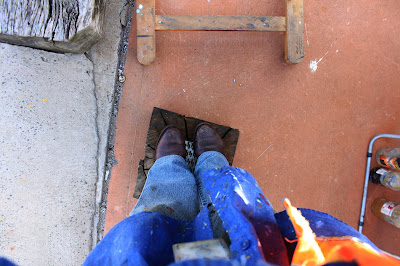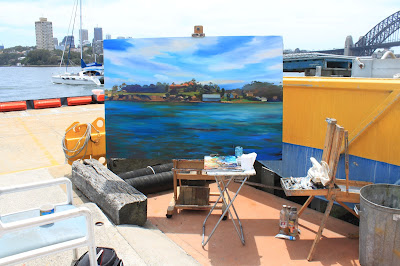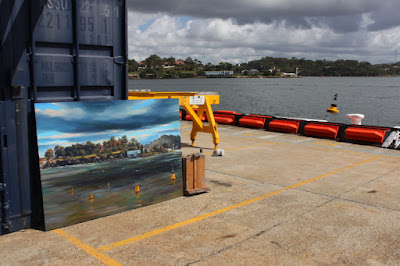I wanted to try painting a large canvas of the spectacular view of Goat Island from Moore's Wharf for my solo exhibition "From the Hungry Mile to Barangaroo" which is now on display at the Frances Keevil Gallery.
I never do anything by halves, so I got the biggest canvas that would fit inside my station wagon - 122 x 183cm!
 |
| My Artist's Studio in a suitcase |
I was worried about the canvas going hang-gliding over Sydney Harbour, or even snapping in two which happened while I was painting the Sydney Heritage Fleet from Blackwattle Bay.
The solution was to take a studio easel as well as a French box easel, and to use cable ties to secure the canvas to the studio easel, and the easel to a large chunk of timber.
The most important thing is not to forget to bring a good sharp pair of scissors to remove the cable ties!
The studio easel had casters so I could move it around without too much trouble. I used the French box easel to store my paint, medium and brushes.
 |
| I've had to cable tie the large canvas to my studio easel |
The renowned 19th century marine painter J.M.W.Turner used to boast that he was once "lashed to the mast" to witness a storm at sea as inspiration.
 |
I've had to cable tie the large canvas to my studio easel- and then cable tie the easel to a timber block!
|
I've always loved Turner's paintings and now I feel that I am literally following in his footsteps!
 |
| Timber block and easel |
Quite literally.
Like Turner,who also had a predilection for painting enormous canvases, I'm also very short, so I had to stand on this useful block of wood so I could reach up to paint the sky!
 |
| Timber block and easel used by plein air painter Jane Bennett |
 |
| My large plein air painting of Goat Island from Moore's Wharf at about 8am |
The day started bright and sunny, but the clouds gathered quickly.
The calm morning Sydney Harbour seascape I had originally intended to paint was soon transformed into a brooding study of an impending storm.
 |
| My large plein air painting of Goat Island from Moore's Wharf at about 9am |
It feels almost as much like a sport as art.
The amount of physical strength involved in just being able to handle a canvas of this size out in the open air is surprising. I have to work out just so I can keep lugging my easels up and down stairs.
The other thing that is underestimated by the people who view the finished canvas in a pristine white-walled gallery, is the amount of concentration required to sustain the atmosphere over the hours required to finish a work of this size.
 |
| My large plein air painting of Goat Island from Moore's Wharf at about 9.30am |
 |
| My large plein air painting of Goat Island from Moore's Wharf at about 10am |
Apart from the skill needed to paint these fleeting effects, it also takes a great deal of experience and judgement to decide which are worth capturing.
 |
| My large plein air painting of Goat Island from Moore's Wharf at about 11am |
Dark clouds started to cover the sky and the sea changed colour from turquoise to prussian blue, then to slate grey.
The wind whipped up, and I had to decide whether it was too risky to continue.
 |
| My large plein air painting of Goat Island from Moore's Wharf at about noon |
I had almost as much canvas to cope with as some of the smaller yachts out on the harbour, who were starting to have trouble.
And if I wasn't careful, my canvas would have travelled just as fast in the wrong direction!
 |
| My large plein air painting of Goat Island from Moore's Wharf at about noon |
The sensible choice probably would have been to put the canvas away and start a small study of the stormy conditions.
But I liked the dramatic light effects so much that I took a calculated risk and quickly repainted the canvas to reflect the changed conditions.
 | |
The completed canvas
|
But I'm glad that I took the risk, as the canvas has really captured the colour and mood.
The brilliant yellow buoys surrounding the excavation of the North Barangaroo Headland Park contrast strongly with the ominous sky and dark, choppy sea.
 | |
|
 | |
|
This photo best shows the painting in context with the landscape.
However large the canvas actually is, it will always look like a postage stamp compared with the real thing. I can assure you that this canvas is a lot bigger than I am!(I am 5' 1" which is fairly short even for a girl.)By the time I took these photos, I was so worried about the canvas blowing away that I had to cable tie it to the container - I didn't dare risk putting it on the easel!
.JPG) | |
Enquiries about this painting
And finally a few days later, here it is hanging in my solo exhibition "From the Hungry Mile to Barangaroo" at the Frances Keevil Gallery.
|





.jpg)





.jpg)

.jpg)



.jpg)





